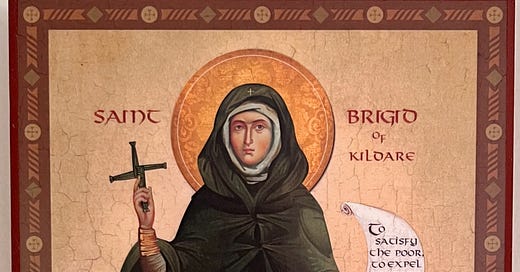Today is St. Brigid’s Day—a celebration of mid-season that has ancient roots. And this year, it is officially a public holiday in Ireland—the first public holiday to honor a woman. A campaign started by the Irish organization Herstory.
St. Brigid (d. 524) is the mother saint of Ireland—and also the patron saint of poets, healers, blacksmiths, seers, and childbirth. There is very little that can be verified of her life historically—she is most likely a syncretization of Christianity with earlier Celtic traditions, of the prominent goddess Brigid, also associated with learning, poetry, prophesy, healing, and metalwork. Some things stay the same the more they change.
As a saint, Brigid was also known to be a friend to animals and closely associated with the natural world. Her center was situated at Kildare—meaning the church of the Oak. And drawing closer to characteristics of other prominent goddesses, the saint was also known to be a patroness of armies who fought on behalf of her province of Leister. Her name reflects this—which means ‘fiery arrow.’ By the twelfth century, there was a perpetual flame kept burning in her shrine until the Reformation and English rule. It was relit in 1993.
Girls and women would make St. Brigid’s crosses from rushes, either in four-armed or three-armed designs, and place them above the entryways of the home and barn, to invoke Brigid’s protection through the year. Pieces of cloth were left out overnight on St. Brigid’s Eve, asking her to bless it with healing powers, and used to help soothe headaches throughout the year.
In the [Herbridean] islands and some Irish communities, [St. Brigid ceremonies] were designed to give a particular prominence, and dignity, to the women of a community—an appropriate phenomenon at the feast of Ireland’s greatest female saint. —Ronald Hutton, The Stations of the Sun: A History of the Ritual Year in Britain
A few years back I bought an icon of St. Brigid, loving the many variations of things—poetry, blacksmithing, animals, healing—that she protects. I’ve never been religious per se, but I do love saint stories and traditions. She watches over my desk for me now, offering feminist poetic solidarity.
And with St. Brigid, in particular, there is a timely aspect to her hagiography—she was recorded as having helped ‘heal’ a nun who had become pregnant: “Brigid, exercising with the most strength of her ineffable faith, blessed her, caused the fetus to disappear without coming to birth, and without pain.” So tell us again, Alito, how abortion has always been considered against the law. St. Brigid would have a word with you….
And so in celebration of St. Brigid and the works of women, some links to share that honor this day’s history:
How St. Brigid was ordained as a bishop, as were the women who followed her—and possibly other women throughout Europe.
Three contemporary Irish women writers wrote poems that accompany short films on St. Brigid’s Day.
St. Brigid traditions and associated rituals have been officially recognized by the state to celebrate and protect living Irish cultural heritage.
More on the history of St. Brigid’s Day and its celebrations.
An experience of St. Brigid’s Day in Kildare.
St. Brigid’s Day marks a festival celebrating Irish women from the past, present, and future.
More on the tradition and history of making St. Brigid’s crosses.
And a poem, from contemporary Irish poet Moya Cannon:
Poem for St. Brigid's Day: A Song at Imbolc
Now at spring’s awakening, short days are lengthening
and after St. Bridget’s Day. I’ll set my sail.
A blind man, on a stone bridge in Galway
or the road to Loughrea, felt the sun’s rays
crops still drowsy in the seed, wheat, flax and oats.
His song rising, he praised Achill’s eagle, Erne’s hawk
and in beloved Mayo, young lambs, kids, foals,
and little babies turning towards birth.
Blind Raftery invoked Bridget, Ceres of the North,
born into slavery at Faughart, near Dundalk
to an Irish chieftain and a foreign slave.
Why, of all small girls in so distant a century born
is she honoured still, in place-names, constant wells,
new rushes plaited to protect hearth, home, and herd?
Bridget, goddess, druidess of oak, or saint - a girl
who gifted her father’s sword to a beggar for bread,
we, who have wounded the engendering seas and earth,
beg you to teach us again, before it grows too late,
your neglected, painstaking arts of nature and of care.Happy St. Brigid’s Day to you all—whether spring is far or near where you are. 🤍








Freya, I really do love this. In memory of the patron mother St Brigid and the Birch stirring under the snow to her awakening- much like a fetal awakening in the mother’s womb. These traditions of women representing art, nature, power, protection and authority over our own bodies makes me emotional and proud to be a woman.
“She watches over my desk for me now, offering feminist poetic solidarity.” I am not a religious person either but I too have a oil on canvas painting of goddess Durga behind my work station and I can clearly feel her protection on days I stray into despair or hopeless. We need our goddess, and we need our sisters. 💜🌼
My grandmother, my mother, and my aunts always made the Brigid crosses every year.
My sisters and cousins still have them above their front doors.
And Doireann Ní Ghríofa is brilliant. Every XY should read A Ghost in the Throat.